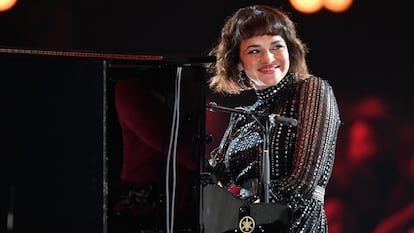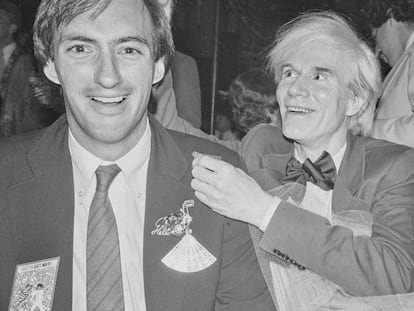Whatever happened to Norah Jones?
The singer-songwriter has re-released ‘Come Away with Me,’ the album that made her famous 20 years ago. But don’t expect to see her in the public eye again any time soon

The year 2002 was a time of transition in popular music. Canadian rockers Nickelback ruled the US Billboard 100 while stars of the previous decades remained high on the list – Pink, Avril Lavigne (who released her single Complicated that year), Sheryl Crow, and Enrique Iglesias. It was the year that Shakira definitively entered the Anglosphere (Whenever Wherever), as did Kylie Minogue’s hooded satin robe in the video for her Can’t Get You Out of My Head.
Against this poppy panorama, nobody saw Norah Jones’ Come Away with Me, well, coming. The debut album of an unknown singer blending elements of jazz and folk on the Blue Note label (previous alumni include John Coltrane and Sonny Rollins) took the world by storm.
Jones is now celebrating two decades of Come Away with Me, a lavishly packaged re-releasd anniversary edition with 44 tracks, a remastered version of the original album and previously unreleased material such as the album’s first demos.
At its time, the album sold 27 million copies while the title track spent several weeks at number one in the US in January 2003 and shortly thereafter won Grammys for Best Vocal Album and Best Pop Album of the Year. Jones herself won Best New Artist.
It has been said that American listeners were looking for a balm to soothe post-9/11 nerves, with Alicia Keys’ Fallin’ also doing that job. While Jones has admitted in a Guardian interview that this might be possible, Come Away with Me reached the peak of its popularity almost a year and a half after the attacks, rendering the theory a little far-fetched. Pundits were trying to explain the outsized success of such an anomalous offering in a context where a niche genre like jazz would not usually appear, or indeed be popular.
Whatever the reason, popular it was. At just 23, Jones had little musical background. She majored in jazz and piano at the University of North Texas, afterwards working as a waitress in the daytime and playing bar gigs in the evenings. When she gave a recital on her 21st birthday, a Blue Note executive was in the audience. She signed with the legendary label shortly thereafter.
Recording Come Away with Me was not easy at first. With the intention of encouraging her the label crowded the recording studio with prestigious musicians, but Jones found this too overwhelming. On the second attempt, Jones was delighted to work with Arif Mardin, who was her idol Aretha Franklin’s producer, along with other legends such as Laura Nyro and Dionne Warwick.
But these were not the names the press would associate Norah Jones with as her star rose. Instead they were obsessed with the fact that Jones was the daughter of sitar virtuoso Ravi Shankar, who collaborated with the Beatles and made his own name as an artist when he played at Woodstock.
No matter that Shankar and Norah’s mother, concert promoter Sue Jones, were never married and had separated when Norah was a child. She changed her surname from Shankar to Jones when she was in her teens and had few dealings with her father until she was 18. By the time she was famous Norah had met Shankar just a handful of times and she disliked being introduced as “Ravi Shankar’s daughter.”
Relations between father and daughter were not improved by her own success.
“It was challenging when we were reunited when I was 18,” explained Jones in an interview with Vogue, saying “all families have their complicated corners.”
“It took us [Shankar and Norah] some time to get comfortable with each other. The success of my first album and the sudden public interest in our relationship complicated everything.”
“I was trying to tell my story honestly while still trying to convey a sense of privacy regarding my unique family dynamic.”
Shankar passed away in 2012 aged 93. As Jones later told Oprah Winfrey, their relationship became more relaxed as he grew older, and the two of them would spend time together watching bad movies such as The Love Guru.
At the time of Come Away with Me’s success, Jones struggled not only with the press fixation on her father but with feelings of deep unhappiness related to her newfound fame. She told Rolling Stone that, while she was being praised all the time, “I was just listening to people criticizing me.”.
“When you’re successful, people want to attack you or analyze why you’re successful and conclude that, well, you’re not that good either. That’s all you hear.”
In those years the singer dated Lee Alexander, who played bass in her band. On her 2009 album The Fall, several songs are dedicated to their breakup which happened around 2007.
Before The Fall, Jones released Feels Like Home in 2004. It topped the best-selling albums charts, with The New Yorker saying the album was like a big “booty call”, apparently surprised at the sexual tone of some of the lyrics.
In The Guardian, critic Alex Petridis gave the album one star out of five, declaring Jones the queen of the soft balladeers billing supermarket-friendly jazz at the time which included Katie Melua, Jamie Cullum and Michael Bublé. The record “floats discreetly around the room like something produced by [air freshener brand] Airwick,” wrote Petridis, extending a certain cruelty to the young songwriter, who, after all, included a duet with Dolly Parton on the album, delving into Nashville’s country roots.
“Feels Like Home is so inoffensive you have a hard time remembering you played it,” added Petrifis. “I suspect that’s the fun for millions of people who buy this kind of thing. They are past the point of wanting to be moved or inspired by rock and pop. Instead they treat music as something ornamental, something with which you can tastefully decorate your home. Beautifully produced and beautifully played to no cumulative effect whatsoever, this album fits the bill perfectly.”
While associated in reviews like this with a derisory wave of ”soft jazz,” Jones’ arrival on the music scene is known as “the Norah effect,” as she opened doors for female singers and songwriters including Amy Winehouse and Joss Stone.
As Norah Jones’ career continued the media let her be, as she never seemed to provoke scandal or salacious headlines about her love life. For Jones, now 41, the closest she might be said to have come to the more predictable “descent into hell” of young pop stars is a time in her life where, by her own admission, she drank too much while on tour in 2007. “I was never a super-destructive drinker, but I still drank a lot, which is not cool,” she said. Her song Tragedy is about a young man who succumbs to alcoholism.
Jones has lived in Brooklyn for the past decade with her partner, musician Pete Remm, and their two children, whose names have never been released. To be sure, Remm’s identity was accidentally revealed to the media by another singer after she asked journalists not to reveal the identity of her husband during promotional interviews she did in 2016.
As she also told press at that time, today Jones lives simply, albeit in a multi-million dollar home, where she has a piano covered in papers and bills within walking distance of the fridge.
Tu suscripción se está usando en otro dispositivo
¿Quieres añadir otro usuario a tu suscripción?
Si continúas leyendo en este dispositivo, no se podrá leer en el otro.
FlechaTu suscripción se está usando en otro dispositivo y solo puedes acceder a EL PAÍS desde un dispositivo a la vez.
Si quieres compartir tu cuenta, cambia tu suscripción a la modalidad Premium, así podrás añadir otro usuario. Cada uno accederá con su propia cuenta de email, lo que os permitirá personalizar vuestra experiencia en EL PAÍS.
¿Tienes una suscripción de empresa? Accede aquí para contratar más cuentas.
En el caso de no saber quién está usando tu cuenta, te recomendamos cambiar tu contraseña aquí.
Si decides continuar compartiendo tu cuenta, este mensaje se mostrará en tu dispositivo y en el de la otra persona que está usando tu cuenta de forma indefinida, afectando a tu experiencia de lectura. Puedes consultar aquí los términos y condiciones de la suscripción digital.
More information
Archived In
Últimas noticias
A survivor’s account of the Interoceanic Train accident: ‘We were scared because of the speed on the curve’
The Interoceanic Train, the Mexican alternative to the Panama Canal
What is known about the Interoceanic Train derailment in Oaxaca
Trump turns a Minnesota fraud allegation into ammunition for his MAGA army against Democrats
Most viewed
- Oona Chaplin: ‘I told James Cameron that I was living in a treehouse and starting a permaculture project with a friend’
- Reinhard Genzel, Nobel laureate in physics: ‘One-minute videos will never give you the truth’
- Why the price of coffee has skyrocketed: from Brazilian plantations to specialty coffee houses
- Pablo Escobar’s hippos: A serious environmental problem, 40 years on
- Chevy Chase, the beloved comedian who was a monster off camera: ‘Not everyone hated him, just the people who’ve worked with him’










































